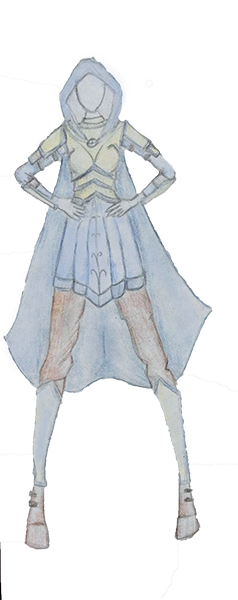Featured Artist: Sophie Nakai
It takes a lot to truly make a character come to life on stage. Behind the curtain, Sophie Nakai exemplifies the skills used to transform an idea into a production.


Every great theater production is propelled by the detailed and extensive work put in behind the scenes. From the precise decision of lighting that guides the mood of every scene to each particular costume design that ensures the complexity of individual characters, backstage production is just as elaborate and important as the show itself. Every step a character takes and every spotlight they stand under is a conscious decision that is executed, rehearsed and perfected. Yet, to truly bring a character to life, actors not only need to play the part, but look it as well. The careful planning that goes into constructing a character’s appearance, from their facial expressions to their costumes, works to generate a full transformation.
Behind the curtain, Paly senior Sophie Nakai plays a role in the meticulous backstage work that goes into a theater production. Although Nakai has been involved in a variety of theater productions since fifth grade, her love for costume began her freshman year of high school. Through working on costume design for Paly theater, Nakai was granted the opportunity to discover a passion that has now resulted in a potential career path for her. Her hard work has subsequently landed her a spot in the freshman class at Carnegie Mellon University School of Drama.
The Beginning
At first, Nakai was an actress, performing in plays for her middle school and the Palo Alto Children’s Theatre. As Nakai grew older, however, she began to find that the spotlight was less enjoyable than before and developed paralyzing stage fright. In eighth grade, this performance anxiety became so prominent that Nakai could no longer go on stage. However, instead of giving up on theater, Nakai made the transition to stage tech and behind the scenes work so she could continue to be a part of what she enjoyed so much.
During her freshman year at Paly, Nakai joined the costume crew and in doing so, was able to delve into a new aspect of theater production. The combination of her love for fashion, history and theatre aligned perfectly with the role of the costume crew. Upon joining, Nakai was introduced to one of her older sister’s friends who took her under her wing. “I learned everything from her,” Nakai said.
As a sophomore, with the teachings of her mentor, Nakai went on to design her first solo show for Paly theatre’s production of Shrek the Musical. Reflecting on the show, Nakai recognizes the great progress that her costume design has made since. “I had absolutely no idea what I was doing,” Nakai said. “I kind of just went for it, my designs were so bad and it’s not even in my portfolio.”
The Shows
Since then, Nakai has completely expanded her skillset as a designer. Her drawings have improved and her research on the characters has become more complex and as a result, so have the final costumes. She began collaborating with other members of the backstage crew, such as the hair and makeup team, to discuss ideas about how the characters should look. In order to strengthen the character analysis used during the design process, Nakai relies on this collaboration with others, even if they are not directly related to design.
In Paly Theatre’s most recent show “Venture”, which told the story of a woman working in the Silicon Valley tech industry, Nakai took inspiration from the objects and people around her to create the costumes. One of the main characters in the show, Callie, wore a costume that was inspired by the Amazon Echo, a small, black cylindrical voice-controlled speaker that performs a variety of commands. Nakai’s aim for Callie’s costume was to have it be sleek, modern and vaguely related to tech in order to compliment the plot of the play.
Movies and pop culture also play a large role in her creative process. For the production of Beauty and the Beast, Nakai looked towards the Disney original movie and other historical references for inspiration. She combined looks from the film, like the gold ball gown and the blue dress that Belle wore, along with different French styles from the 1750s. This play, in particular, provided Nakai with a chance to fully mix her love for history and fashion.
The Future
One of the most notable and rewarding experiences of Nakai’s time as a costume designer was her invitation to attend the Carnegie Mellon University Pre-College Summer Program on a full-ride scholarship. Throughout the course of six weeks, Nakai and 12 other students participated in ten different classes in the design and production program offered at the university. The classes consisted of a range of skills that Nakai had never studied before: carpentry, backstage lighting, sound design and painting.
She specifically recalls working with a professor, who was an award winning costume designer, and learning about figure drawing, a technique used to draw the human form in a way that is helpful for costume designers. It creates a visual for how the body looks and and how the costumes will fit. From the same professor, Nakai was also able to acquire knowledge on how to make a scale inch model, understand how fabrics look on different body types and how to blend a character into a setting so that they become a part of it rather than stand out. “I understand what I am doing now,” Nakai said. “I know the process of design, how to design and how to work with other people better than I did when I was a sophomore.”
After attending the summer program at Carnegie Mellon, Nakai completed an exit interview in which she reflected upon her experiences throughout the summer and shared her design portfolio with a team of reviewers. Nakai presented her scale-inch models, draftings and the blue dress design used for Belle in the production of Beauty and the Beast. Soon afterwards, she received her evaluations of the interview in the mail and was formally invited to the freshman class of 2022, which Nakai will be joining this coming fall.
Although Nakai’s plan is to major in costume design, she will be taking classes in all different areas of stage tech during her first semester at Carnegie Mellon in order to fully solidify what she wants to do. The School of Dramatic Arts, which Nakai will be attending, has a three percent acceptance rate and will play a significant role in determining her future as a designer.
Nakai’s theater experience from performer to designer and her transition from one side of the curtain to the other is a unique story that shows the possibilities and opportunities that can come from starting something new.
Art courtesy of Sophie Nakai










